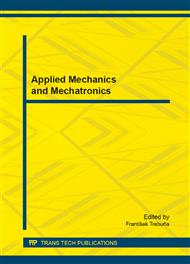p.239
p.245
p.252
p.256
p.265
p.273
p.279
p.284
p.294
Regression Model Design for the Prediction of Pipe Conveyor Belt Contact Forces on Idler Rollers by Experimental Tests
Abstract:
In this paper there is presented a possibility to estimate, with a sufficient accuracy, contact forces on idler rollers of hexagonal idler housing in case of the pipe conveyor belt. This prediction is based on values of tension forces that are measured experimentally. The calculated regressive models are able to predict contact forces in individual positions of idler rollers with suitable correctness. The measurements of tension forces were carried out on a static model of a pipe conveyor. This static model is able to simulate real operational conditions of idler rollers, which guide the conveyor belt. In this way it is very simply possible to determine contact force values in the individual positions of idler rollers. Information about contact forces is useful for designers and for users of the conveyor belts, as well.
Info:
Periodical:
Pages:
265-272
Citation:
Online since:
August 2014
Authors:
Price:
Сopyright:
© 2014 Trans Tech Publications Ltd. All Rights Reserved
Share:
Citation:


